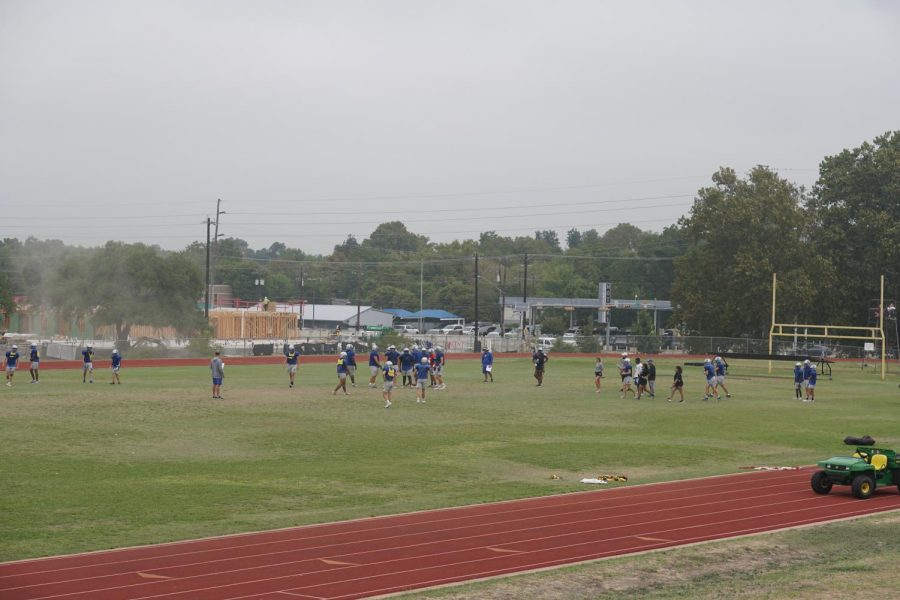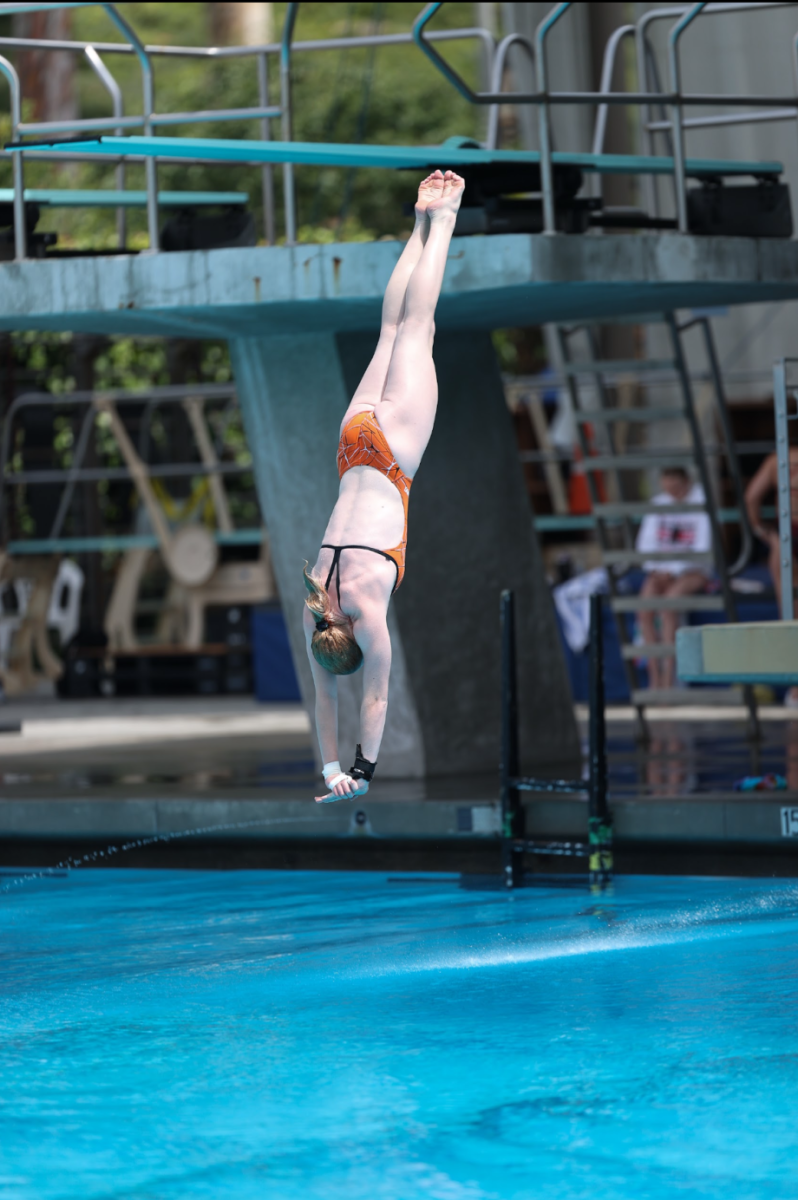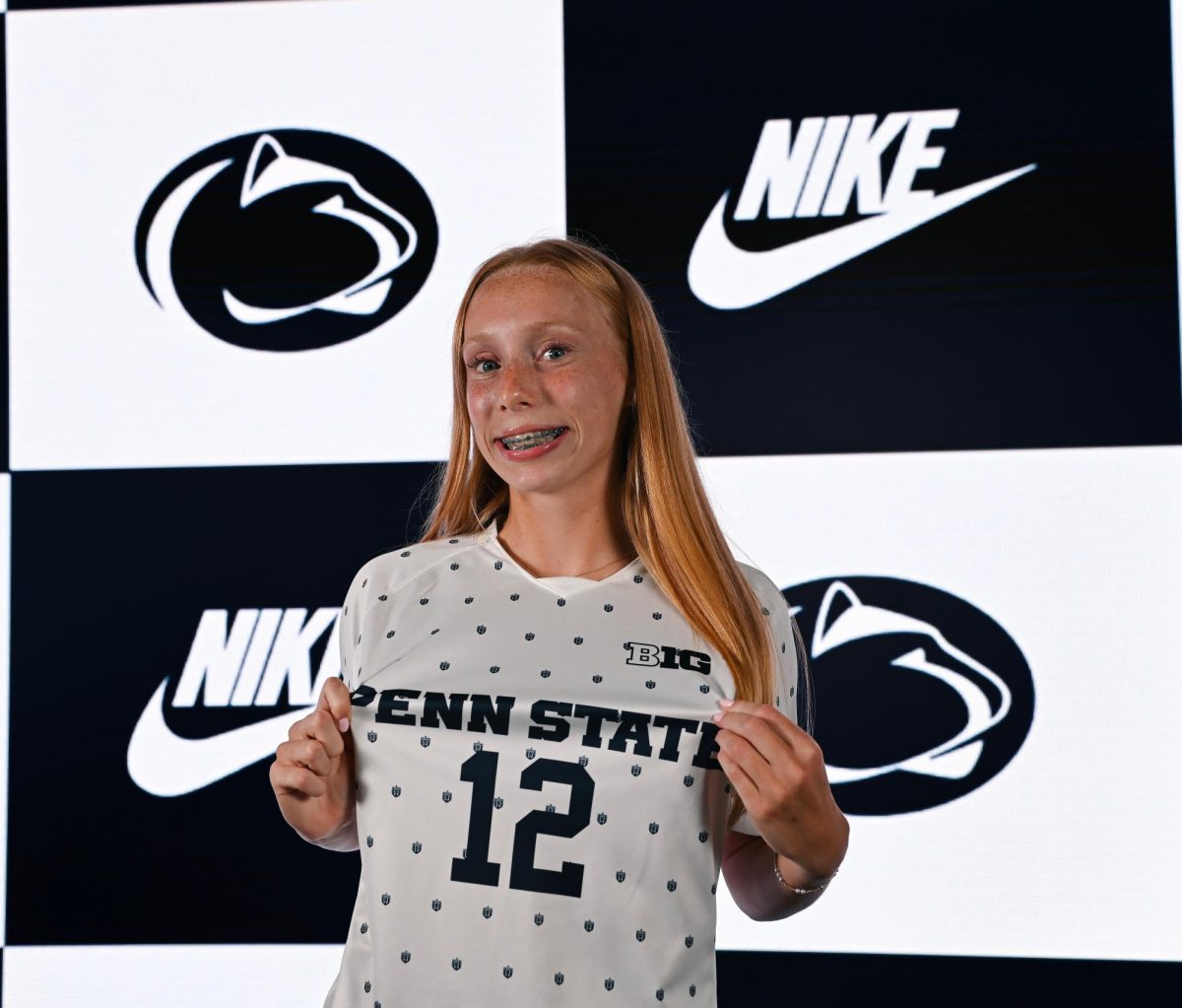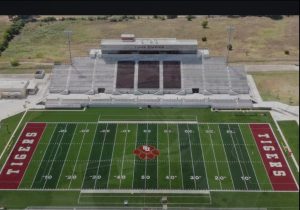
TIGER TIME. Dripping springs multi million dollar stadium has a capacity of 8000 people; 5000 on the home side and 3000 on the away side. This turf field is utilized for soccer, football and other sports. Photo reposted with permission from Dripping Springs High School website.
Ant bites. That’s an injury the McCallum football players are worried about, ant bites. The field is full of the eusocial insects, the little things squirming around the mounds and piles of dirt that are scattered sporadically on the multi-purpose field that the team utilizes for practice.
“It’s a crap shoot if we can practice when it rains,” senior wide receiver Griffin Kelly said. “Most of the time the gym and the mat room are being used by basketball, volleyball or cheer.”
Outside of the city, it’s 4:30 p.m; the bell rang 15 minutes ago, and the sky is blanketed with clouds. It’s drizzling lightly in Dripping Springs and, the Tiger football team is starting their warm-up on a slightly wet turf field. Right next to the field they are occupying sits Tiger Stadium, a multi-million dollar, 8,000-seat stadium that on Friday nights is the No. 1 place people in Dripping Springs want to be.
Growing up in Austin you hear about the big schools, Lake Travis, Westlake, Austin High, Dripping Springs, programs with team merchandise stores, tailgating parties and indoor practice facilities. Programs that don’t ever have to worry if their helmets are up to code or if their field can be practiced on. These big-ticket schools boast athletes that have gone on to play D1 in college and eventually to the NFL. The most legendary of their players even hold the record for the most pass yards of all time.
With an Oct. 4 in-depth investigative piece entitled, “Why High Poverty Schools Lose More Football Games,” The Austin American-Statesman raised the question of whether high school football teams in central Texas play on a level playing field or whether teams win or lose entirely based on socioeconomic status of the student population and the resources available to the football program as a result. The story prompted The Shield to ask the question at our own school: do the resources available to Mac football affect the outcome of the team’s games and if so, how?
Senior Darius Lewis attends Del Valle, but he spent his junior year at McCallum playing football and basketball. Lewis said he switched schools because it was cheaper for his family to move out of the city, but he is in a unique position to compare McCallum’s resources to those of another school.
“At McCallum, the weight room and the facility are much smaller than at Del Valle,” Lewis said.
When Lewis went to McCallum he spent morning and afternoon practices on a dirt, mud and potholed field. At Del Valle, Lewis now practices in a turf field indoor practice area and a state-of-the-art weight room. In the uber-competitive UIL District 25-6A, Del Valle is 3-4 with an overall record of 5-4.
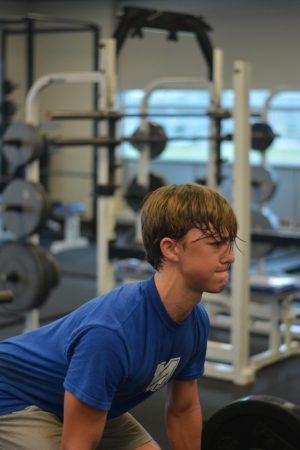
GUENTHER’S GAINS. During morning workouts, sophomore Ez Guenther deadlifts in the weight room that was re-done three years ago. “It’s a lot nicer now”, senior Griffin Kelly said. “We got some new equipment, but they just remodeled the room. We still have the old stuff.” Kelly was accustomed to the old weight room he used during his freshman year. Photo by Grace Nugent.
It’s not just practice spaces and equipment that distinguish the haves from the have-nots. The size of the coaching staff also makes up a big part. Dripping Springs High school has 13 football coaches; in comparison, McCallum has nine.
More coaches mean that the athletes get more one-on-one instruction; there are specific coaches just in charge of freshmen or only in charge of safeties. Along with football obligations and teaching classes, lots of coaches are in charge of all equipment and field care. At understaffed programs, the coaches must work overtime in order to provide the same services to the team. And it’s not just the coaching staff that’s smaller.
McCallum has a smaller-than-regulation size grass auxiliary field, two gymnasiums, and one grass field. Dripping Springs has three gymnasiums, an 8,000-seat capacity turf field stadium, and two turf multi-purpose fields. Last year while the McCallum girls and boys soccer teams were in the heat of the playoffs, the two fields at McCallum were being reseeded barring all sports from practicing or even walking on them.
Booster clubs are a big part of the high school football experience. Coaches communicate to the booster clubs what their wants and needs are and the booster clubs try to make those wants a reality.
“The booster money could go to a nutrition plan, different programs like that,” said McCallum Football Booster Club president Michelle Rosales. “We aren’t there yet because we are still trying to get some of the basics.”
The booster club has three fundraisers that they use to raise money: selling signs to businesses, the McCallum merchandise sold at games and ads in the football program.
Booster club memberships range from $25 to $1,000, with business sponsorships at $1,000. By comparison, at Dripping Springs, business sponsorships are anywhere from $1,500 to $6,500.
“Our next goal is gonna be knee braces for the linemen,” Rosales said. “Well, those are $700 a set, and they need about 10 of them, so now it’s our job to try to fund-raise for something that is vital for the player’s safety.”
While the booster club is trying to get knee braces of the linemen, Seguin High School is remodeling its stadium that already houses a $1.35 million dollar video board. Players say they are grateful for AISD fields like House Park and Nelson and they may notice that the non-AISD schools have more bells and whistles surrounding their program, but Kelly says, in the end, the will to win has to come from inside a player not from external resources.
“It helps to have the practice rain or shine idea, but I think it really comes down to the players you have and the effort they put in,” Kelly said.
Better facilities do contribute to game outcomes and the level of play, but many players contend that effort and attitude are more important factors.
“The work that gets done at McCallum is unmatched,” Lewis said. “The productivity level in a day’s work is different than all of the schools I’ve been to. That’s pretty much a thumbs up to Coach G honestly.”
Some things money just can’t buy.



